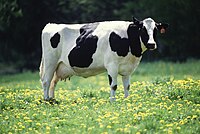
Photo from wikipedia
Abstract Dairy cows, methane and global warming have become publicly related terms. However, appropriate dairy cow management may in fact be part of the climate solution when viewed as part… Click to show full abstract
Abstract Dairy cows, methane and global warming have become publicly related terms. However, appropriate dairy cow management may in fact be part of the climate solution when viewed as part of the biogenic carbon cycle. Accordingly, governments and consumers are encouraging more sustainable, locally produced, climate friendly dairy production that often includes grassland‐based feeding. However, this system is presumed to result in greater methane emissions compared to corn silage‐ or concentrate‐based diets. An increase in urine nitrogen, associated with increased ammonia and nitrous oxide emission potential, questions the environmental usefulness of this strategy pertaining to global warming. This study is the first to compare the effects of incremental increases of grass silage proportion on enteric methane production as well as N and energy losses in dairy cows. Twenty‐four mid‐ to end‐lactation dairy cows were each fed one of 24 different diets, from two different harvest years, gradually increasing in grassland‐based feeds (grass silage and hay) from about 500 to 1000 g/kg and concomitantly decreasing in corn silage. Each cow underwent a 7‐day total collection period and was housed for 48 h in respiration chambers. Incremental data were subjected to an approved parametric regression analysis approach. The dietary increase in grassland‐based feeds did not impair milk yield, N and energy utilisation. Simplified regression equations revealed that, contrary to current assumptions, there was a decline in methane production from 373 to 303 g/day when increasing grassland‐based feeds from 500 to 1000 g/kg diet, and there was a trend for a decline in emission intensity from 20.6 to 17.6 g/kg of energy‐corrected milk. However, urine nitrogen emissions clearly increased even when related to nitrogen intake; the latter from 260 to 364 g/kg when increasing grassland‐based feeds from 500 to 1000 g/kg. Methane and urine nitrogen emissions were not affected by year of harvest.
Journal Title: Journal of Animal Physiology and Animal Nutrition
Year Published: 2022
Link to full text (if available)
Share on Social Media: Sign Up to like & get
recommendations!